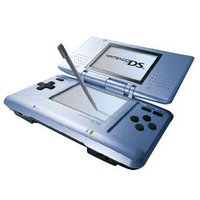
Today,
Steve Jobs announced the iPhone at MacWorld 2007. It was met with many cheers and jeers, probably even some leers. Still, there's no doubt it will raise the bar for future portable devices to come, now that manufacturers will have to refocus their efforts on coming up with the "iPhone-killer".
Some time back, I wrote a wish-list of features that I would like in
the ideal ultimate gadget. The technical specs on Apple's website, while not quite matching up, come closer than a lot of devices I've seen. Here's the blow-by-blow comparison:
| Handheld Holy Grail | Apple iPhone |
- 4" screen with at least 1024x640 pixels
- Standardized video output for hooking up to a bigger screen
- Minimum of 3 megapixel camera
| - 3.5" widescreen with 320x480 pixels at 160 dpi. However, the screenshots show webpages at full size rather than puny mobile phone versions.
- Video output not mentioned, though Steve did have one on his "special" iPhone at MacWorld.
- 2 megapixel camera
|
- Should be able to handle graphics as well as a Nintendo DS
- Buttons should be in strategic places, like the Sony PSP
| Gaming on the iPhone hasn't been mentioned as of yet, but it looks more than capable of great graphics. However, without buttons it may be less than ideal as a gaming device. |
- Office-like applications
- E-book readers
- E-mail client
- Web browser
| I understand the iPhone will not have 3rd party application support, even though it will run OS X, so it may not be capable of running an office suite. That said, webpages on its built in Safari browser looks amazing on a 3.5" screen. For e-mail, Apple has partnered with Yahoo for free push-IMAP e-mail -- look out BlackBerry! |
- VoIP programs
- Instant messaging
- Cellular phone capability (if that's still needed by then)
| Cingular will be the exclusive GSM carrier in the United States, but without 3rd party apps, VoIP and IM programs may be excluded.
|
- Speech recognition and Text-to-Speech
- GPS maps, driving directions, and business search
- Fold-up or slide-in mini QWERTY keyboard
- Battery life lasting at least 24 hours when idle, 10 hours when using voice and low graphics activity, and 5 hours when gaming and watching videos
- At least 16GB flash memory
- USB and Firewire output
- USB input (maybe for one of those laptop lights, or just downloading files from a memory stick)
- Wireless (bluetooth or otherwise) interface for keyboard, headset, and other functions
| - No word on speech recognition, though OS X is certainly capable of it
- Apple has partnered with Google Maps and features click-to-call for businesses but doesn't mention GPS
- Soft keyboard only, with intuitive error reduction and correction
- Up to 5 hours battery Talk/Video/Browsing, and up to 16 hours for audio playback with no mention of standby battery life
- Initial choice of 4GB or 8GB flash memory
|
In that article, I had prefaced the list with this statement:
The operating system doesn't matter much, as long as it's open for some hacking around and creating new programs.
And so I was excited to hear Steve say that the iPhone would run OS X, which is built on Unix, only to be let down later when I read this
Engadget article that said it would be locked to outside programming.
The real reason this is such an explosive announcement isn't just the new product itself, but the innovative
user interface. The patented multi-touch screen makes navigation look almost effortless. It's just a scroll here, a tap there, or a "pinch" to zoom in on your photos, maps and websites.
The iPhone also has a proximity sensor that turns off the screen when you hold the cellphone up against your face or put it in your pocket, plus an accelerometer that automatically knows when to show the display in portrait and landscape mode.
Another first is the use of "visual voicemail", which shows you a list of voice mails with the callerID, and lets you choose the order in which to listen to them.
The Apple iPhone is expected to ship in June, pending FCC approval and a
Cisco lawsuit for trademark infringement, with a price tag of $499 for the 4GB version and $599 for the 8GB version, when you sign a 2 year contract with Cingular of course.
Categories:
Apple, iPhone, Steve Jobs, iPod, Holy Grail, Gadget, Mobile, VoIP, WiFi, PSP, Cingular, VoIP Service
 VoIP has moved beyond reality into the realm of the virtual world we know as Second Life. Skype Journal announces:
VoIP has moved beyond reality into the realm of the virtual world we know as Second Life. Skype Journal announces: I've scoured the 'net and found some projects currently underway that claim to do just that, albeit with limitations.
I've scoured the 'net and found some projects currently underway that claim to do just that, albeit with limitations. Today,
Today, 